Contributor Essays
Noise Screen and Ghost Images
Acoustic Borderlands at Frankfurt Airport
by Susanne Bauer, Nils Güttler and Martina Schlünder
October 26, 2020
At Frankfurt Airport a large gray concrete wall dominates the area near the gate to the airport’s cargo facilities (Fig. 1). Cars, logistics vans, and employees arriving by bus pass through this gate on their way to the logistics buildings and apron. The massive construction—15 meters high, 2.6 kilometers long—is reminiscent of a medieval city wall but has nothing to do with airport security. Installed by the airport operator in the early 1970s, it protects neighboring residential areas against noise from the new cargo terminal.
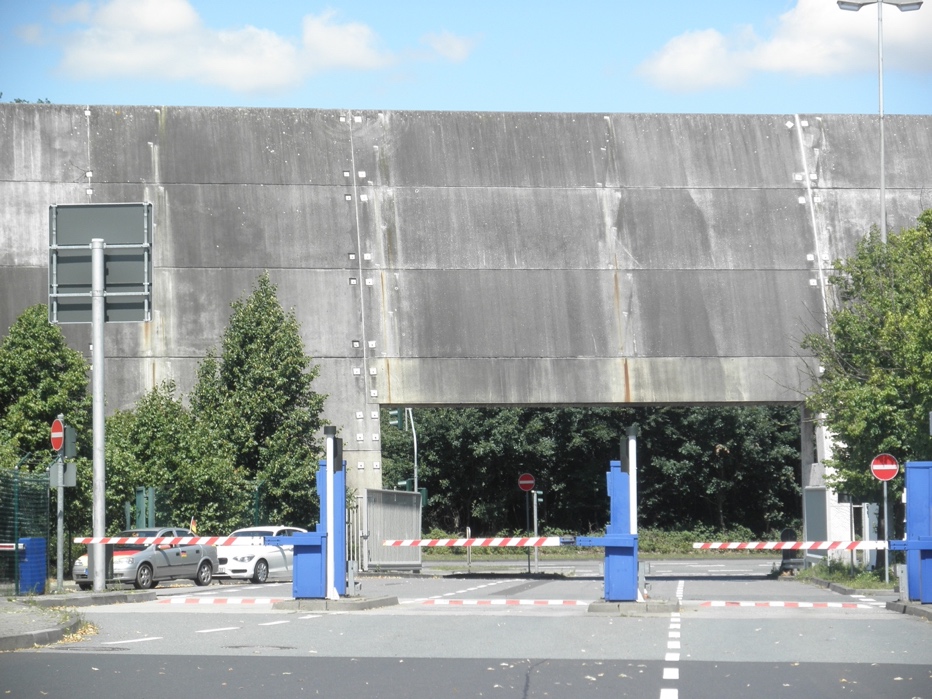
This noise screen embodies the tension that permeates the airport’s acoustic “borderlands”—we use the term in reference to Gloria Anzaldúa’s seminal writings on the US–Mexican border. Borders are usually associated with a clear-cut line or a material separation, but noise cannot be contained, varies over time, and depends on weather and other environmental conditions. Borders are usually contingent or imposed arbitrarily, while noise resides in the very materiality of air and cannot be controlled through practices of separation, like fencing off something that is tied to a particular place. Noise defies most of the practices that enact borders, such as the spatial separation between Schengen and non-Schengen areas. Its opposite—complete silence—scarcely exists in everyday environments. In fact, in air travel the absence of noise—when engines go silent during flight—can mean extreme danger. Chesley “Sully” Sullenberger, the pilot of the flight forced to make an emergency water landing on the Hudson River in January 2009, reported complete silence after his plane was hit by a flock of Canadian geese and both engines stopped working.
Airport noise has posed a problem since the dawn of the jet age. In 1966, the Frankfurt flight noise commission was established to implement noise abatement by limiting takeoffs, landings, and engine testing at night; standardizing the measurement of airport noise and establishing monitoring procedures; and defining and calculating acceptable “acoustic dose” values for noise limit guidelines. As historian of technology Karin Bijsterveld has shown, the quantification of traffic noise and its physiological effects as well as the study of noise abatement emerged as research fields during the early twentieth century. Noise abatement in engineering considered a wide range of management technologies: from keeping noise at a distance, to building sound screens or “anti-sound” interventions, to reducing noise at its source. Noise research has asked how sound physiologically affects humans and animals.
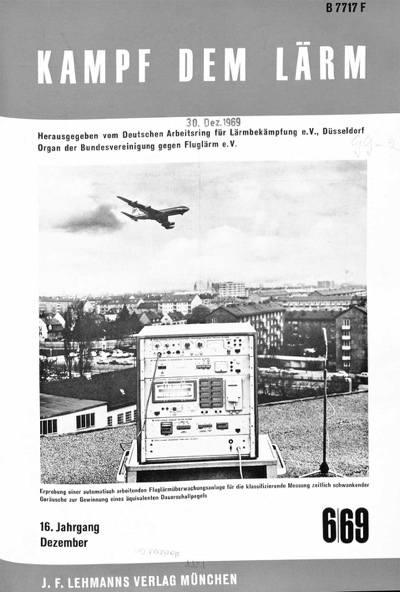
Fluglärmüberwachungsanlage 1969, Cover 6/1969.
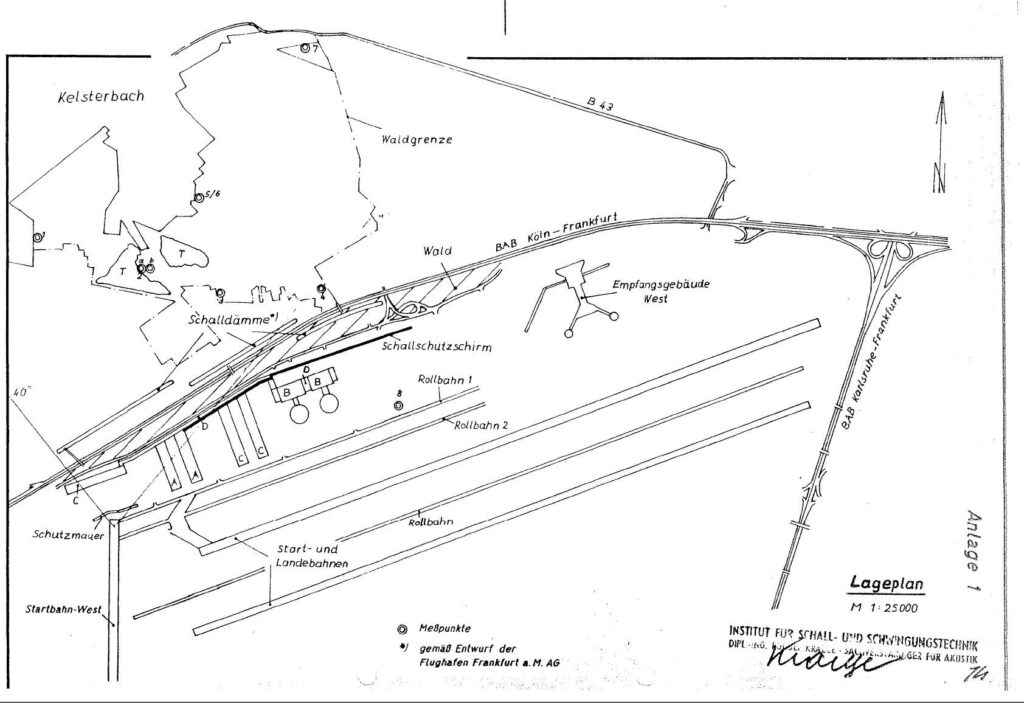
In the 1960s, the expansion of the Frankfurt Airport and the construction of a new cargo terminal made it more urgent than ever to address the noise issue (Fig. 2). Both expert committees and nearby municipalities raised concerns over noise pollution, especially in residential areas adjacent to the transportation infrastructures. The massive concrete wall was built to the northwest of Frankfurt Airport, in an area of woodlands (Fig. 3). The town of Kelsterbach is located downwind from several simultaneous sources of noise; under certain wind conditions sound accumulates into a sonic storm generated by a nearby highway and highspeed train line, airplane takeoffs and landings, and (especially problematic) the sonic vibrations generated by ground operations at the cargo terminal.
A 1968 contract between Kelsterbach and the airport operator FAG (now renamed Fraport) formalized the relationship between the airport’s sound emissions and the nearby town. The contract covered several areas of environmental impact, from forest management to noise, and included an agreement requiring the airport operator to install and pay for noise abatement to protect residential areas from the noise of ground cargo operations. The airport also attempted to provide compensation for the destruction of forest areas and the loss of biodiversity by paying for reforestation and, later, the relocation of protected species as well as biodiversity monitoring and conservation measures to increase biodiversity outside the airport and elsewhere in the region. Sound, however, proved to be a more complicated problem to address.
The noise screen, built in several stages between 1970 and 1984, is a material enactment of attempts to mitigate noise from ground operations. It was erected to control the cargo terminal’s sonic waves, which would otherwise exceed the boundaries of the airport and impact surrounding areas. Acoustics engineers based in Hamburg were tasked with planning the acoustic border after conducting sound measurements at different points between the airport and residential areas. The contract included a map of planned and existing installations and noise measurements at several observation points, calculating noise levels and their sources as well as charting “effective noise zones” (Figs. 3 and 4).
In 1977, the second phase of the noise screen’s construction produced some unexpected effects. Due to its height, the concrete structure reflected radar signals, especially when it was raining. An article in the trade journal Unser Flughafen called these radar reflections that appeared on the control tower monitors Geisterbilder (ghost images). These phantasmal images closely resembled aircraft movements on the radar screens and thus created problems for air traffic controllers (Fig. 5). In order to provisionally solve the problem until a new radar tower was opened in 1979, “reflection traps” were mounted on the noise screen so that the radar signals appeared as several smaller structures instead of a large structure or a moving object—thus banishing the ghosts from the monitors. Constructed to interrupt the acoustics of cargo ground operations, the concrete wall had an unexpected visual impact that haunted the radar screens of air traffic control.
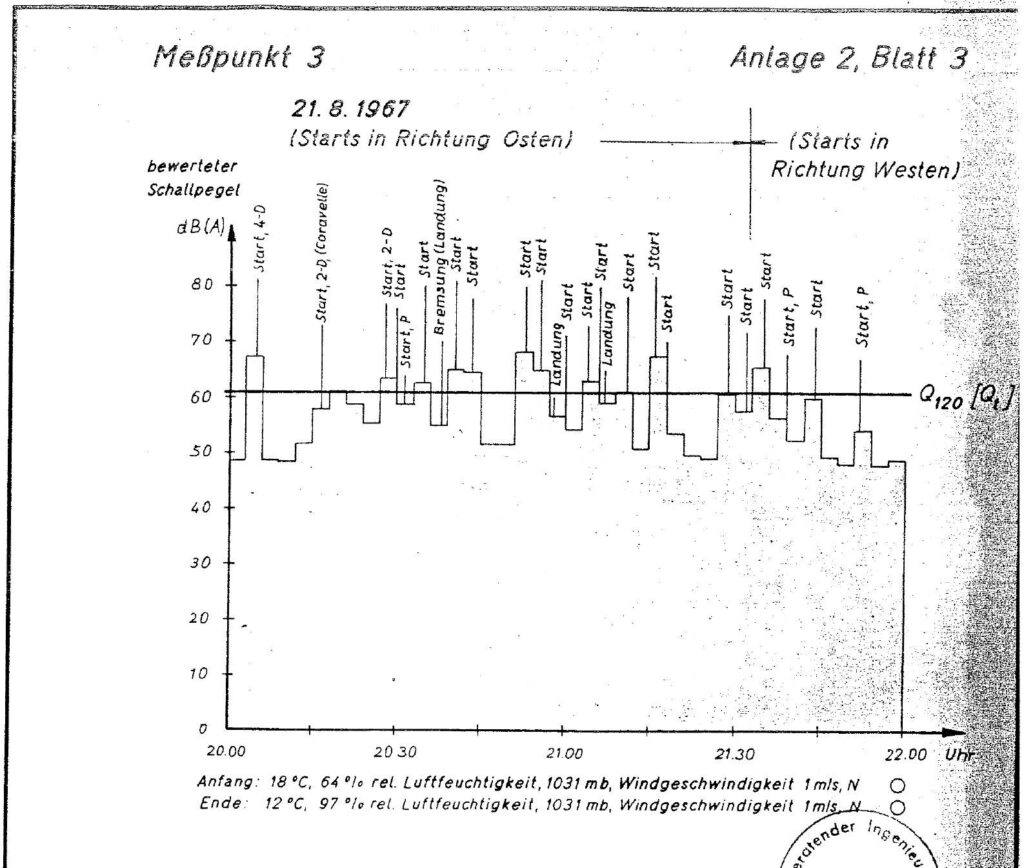
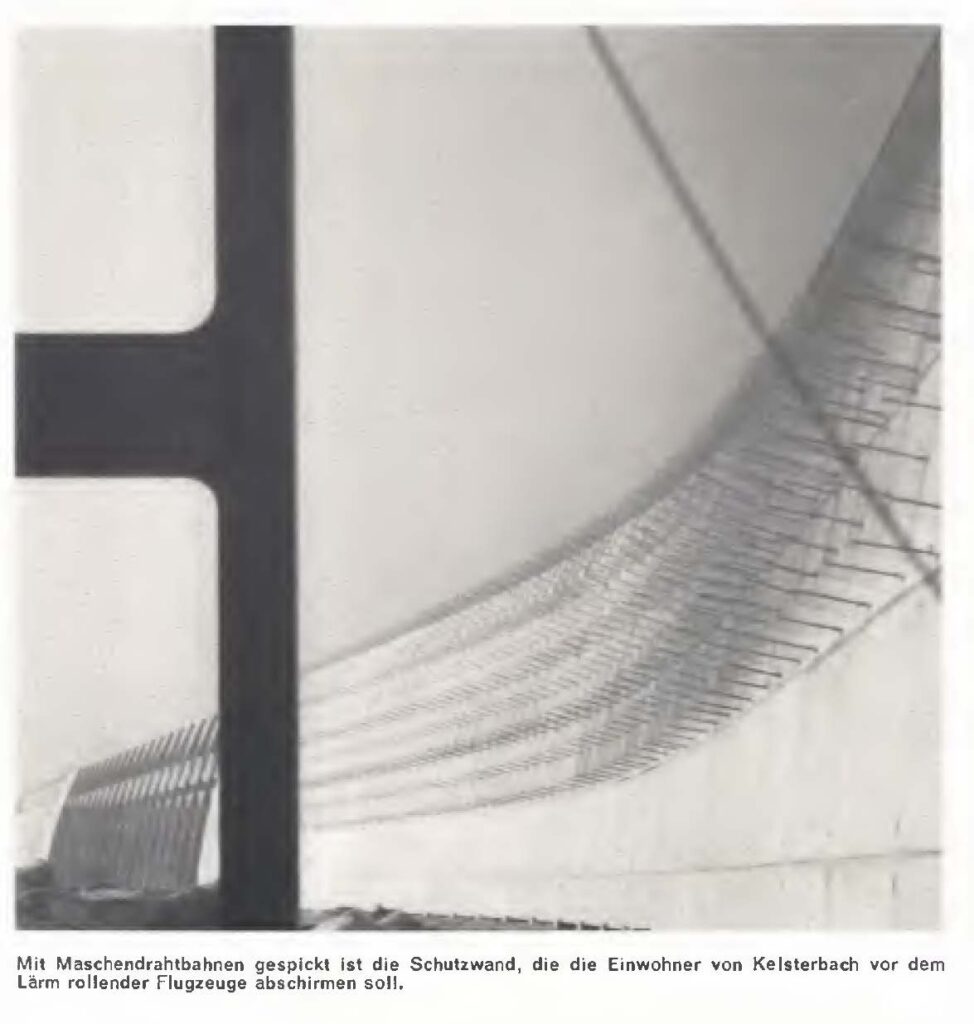
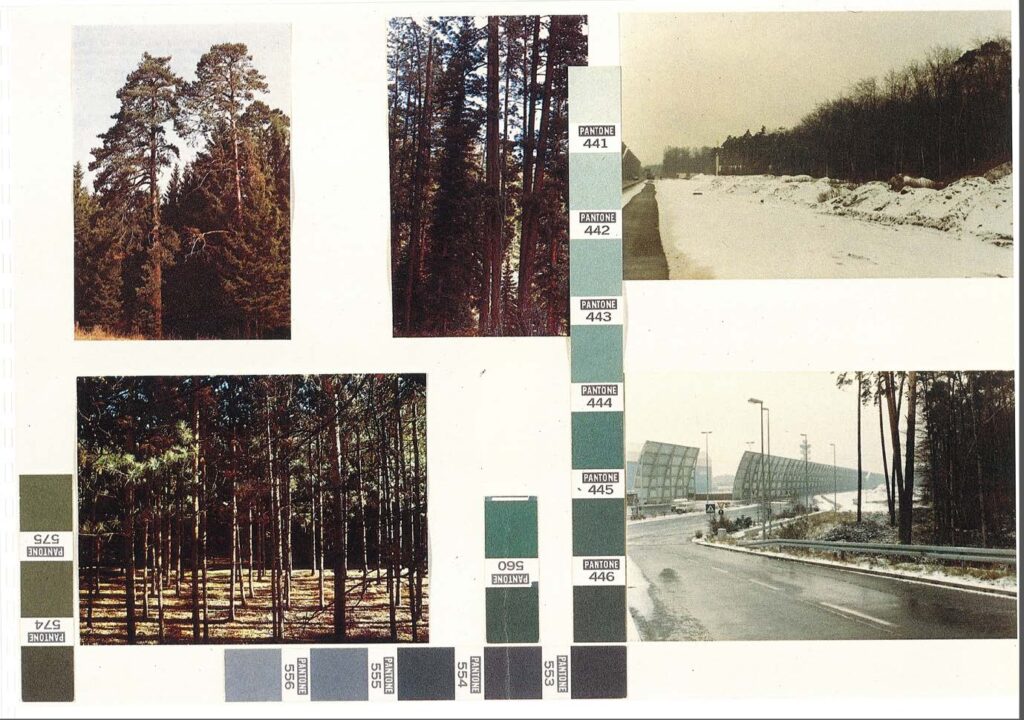
The planning process for the noise screen also included a color design (Fig. 6) created by a regional office for landscape architecture, which mimicked the palette of the local vegetation. (The side facing the apron was painted with logos of leading airlines and aviation companies.) Although Frankfurt Airport is now the third largest in Europe and has more than doubled its surface area, it is still almost completely surrounded by woodland. This urban forest is a recreational area known for its biodiversity. In turn, Frankfurt Airport’s identity as a woodland airport has required ongoing border management as the airport has expanded.
The forest surrounding the airport may be thought of as a noisy landscape garden—an experience shared by people living close by, those who visit it, and the protestors who built a makeshift village in the late 1970s. During protests against the construction of a new runway, demonstrators noted in an activist magazine: “You are powerless when it comes to noise. You can try to shout at it—it’s no use.”
Over time, airport noise and the enduring impact of a major transportation hub have also negatively influenced property value and rents, leading to increased social stratification of the airport’s surroundings. A legacy of acoustic management, the massive concrete outlines of the noise screen have left permanent marks on the airport’s acoustic borderlands, while the various other boundaries have been less permanent and subject to transformation. The noise is situated between the cargo area and the Frankfurt–Cologne highway but also between the cargo area and the new northwest runway that opened in 2011. Repeated airport expansions have altered the noise screen’s functionality, changed its effects, and even made it obsolete. In 2016, engineers recalculated noise emissions in Kelsterbach with and without the concrete wall, taking new sources of noise into account along with several changes in land use due to the development of an area previously used as parking lots. Given these changes and additional acoustic layers absent during the original planning, engineers have advocated tearing down the existing wall and building a lower noise screen of 8 meters, which would adapt to the current situation while still complying with the 1968 contract.
Acoustic borderlands are still present at the airport and pose a persistent challenge to management strategies. Anzaldúa’s work helps us to sense the transmissions and interferences—aerial, visual, and acoustic—within these borderlands. The noise of the jet age necessitated this monstrous noise screen, which is today nearly obsolete. It was constructed to block aerial sound propagation but later altered and camouflaged to avoid interfering with radar signals. No strategies of appeasement can resolve this tension without considering that if airport noise, at a very visceral and sensory level, remains an uncontrollable nuisance to those who inhabit and resist the zones of sound propagation around air traffic hubs, its opposite—silence after engine failure—can mean the utmost danger to modern technical systems of aircraft operation.









